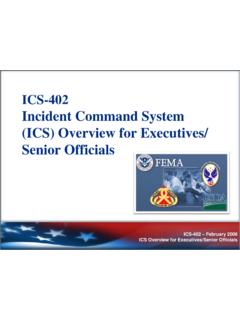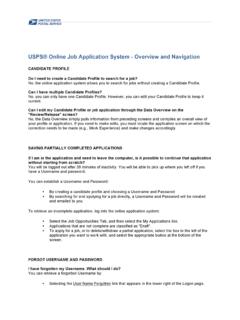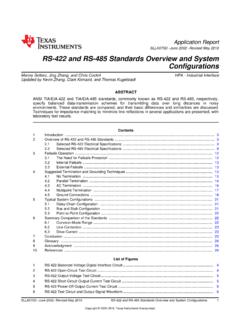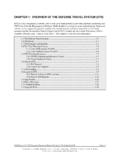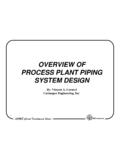Transcription of An overview of marine vapour control system safety ...
1 LIQUID, CHEMICAL. AND GAS HANDLING. An overview of marine vapour control system safety requirements W. N. Tuttle, & J. W. Young, , Warner Nicholson Engineering Consultants, , USA. The generation of flammable vapours during cargo transfer into marine vessels presents numerous hazards even without the implementation of vapour control systems. Some of these hazards are: cargo tank overfill, cargo spillage, and fire and/or detonation of the cargo or its vapours. When vapour control is included, additional hazards can be introduced by the very nature of the vapour containment system . These hazards include, in addition to the ones already listed, over or under pressuring the marine vessel, inclusion of sources of ignition such as vapour conveying equipment, vapour destruction or recovery equipment, etc. The United States Coast Guard (USCG), under the authority of section 183(f) of the United States Clean Air Act, issued regulations in 1990 to ensure the safety of personnel, equipment and operations of a facility marine vapour control Systems (MVCS) which contain and control the emission of vapours emitted from a marine vessel's cargo tanks during the loading of crude oil, gasoline blends, or benzene.
2 In subsequent years further cargoes were included and the control of these was Figure 1. Dual Loading Dock Skid showing the vapour Hose connection, added to the original regulations by USCG policy letters. Pressure-Vacuum Relief Valve, Hand Operated Block Valve, Quick Closing At this moment the United States Coast Guard Regulations vapour Valve, Filter and USCG approved Type 1 Detonation Arrestor. coupled with the policy letters are the most comprehensive set of safety requirements for MVCS currently being enforced. Numerous countries have either emulated these regulations with the addition of local requirements or have adopted them in whole with the exception of the requirement for USCG Certification of the MVCS. One of the features of the current USCG regulations within the USCG jurisdiction is a third party Certifying Entity (CE) review of the design, installation and operation of the MVCS.
3 Some terminal operators, outside of the USCG jurisdiction, have voluntarily chosen to follow the USCG Regulations and have requested a third party Certifying Entity review of their systems to insure compliance with the safety requirements. The pertinent USCG Regulations may be found in the Code of Federal Regulations (CFR), 33 CFR Part 154, Subpart E. (For the complete text of these and other regulations please go to at the bottom of the page click on the desired regulation). These regulations contain the requirements for facility based vapour control systems. In these regulations reference is made to earlier USCG Regulations that deal with the requirements for the marine vessels themselves. For example, 46 CFR Part 39, Subpart D contains the majority Figure 2. Facility vapour Connection properly labeled and painted with the of vessel vapour control regulations and the requirements for the isolation flange clearly visible.
4 vapour collection equipment installed on marine vessels. Other applicable regulations for vessel MVCS and loading marine vessel requirements operations are contained in 33 CFR section (Oil transfer procedures), 33 CFR section (Requirements Important areas addressed by 46 CFR Part 39 include: for transfer), 33 CFR section (Equipment tests and Cargo gauging system ( ) inspections), and 46 CFR section (c) (Declaration Tank ship liquid overfill protection ( ) of inspection). vapour overpressure and vacuum protection ( ) Although the regulations permit vapour to be processed on board a marine vessel, in most cases the collected vapours are High and low vapour pressure protection for tank ships ( ). sent ashore to the facility MVCS for processing. If the vapour Operational requirements ( ) processing unit is located on board a marine vessel, it too must Lightering and topping-off operations with vapour balancing meet the requirements of 33 CFR part 154, subpart E to the ( ) satisfaction of the Commandant of the Coast Guard in addition Personnel training ( ) to complying with the requirements of 46 CFR part 39.
5 156 P O RT T E C H N O L O G Y I N T E R N AT I O N A L LIQUID, CHEMICAL. AND GAS HANDLING. balancing (returning the collected vapours to facility storage tank). The majority of existing facility MVCS utilise either vapour destruction or vapour recovery few installations utilise vapour balancing. In general, major components of most of these MVCS include a vapour destruction unit, or vapour recovery unit; a liquid knock out drum; vapour blowers, detonation arrestors and flame arrestors; oxygen or hydrocarbon analyzers; pressure/vacuum relief valves; and emergency shutoff valves. vapour destruction equipment requires additional safety measures that include liquid seals, and vapour enriching, inerting, or diluting systems. The bulk of the requirements for facility MVCS are contained in the regulations of 33 CFR 154, Subpart E. These regulations address the design and operational aspects of facility based MVCS.
6 Focusing on the following areas: Liquid overfill protection ( ). Overpressure and vacuum protection ( ). Fire, explosion and detonation protection ( ). Requirements for inerting, enriching and diluting systems ( ). vapour compressors and blowers ( ). vapour recovery and vapour destruction systems ( ). Figure 3. MVCS End control Device a vapour Combustor. Personnel training and operating requirements ( and ). Design, performance, and testing standards for detonation and Facility requirements flame arresters ( 154 Appendix A and B). The typical facility installed MVCS consists of a vapour collection Additional Requirements for Cargoes Other Than Crude Oil, system , an arrangement of piping and hoses, and a vapour Gasoline, and Benzene processing unit used to recover or destroy the collected vapours. The MVCS requirements found in 33 and 46 CFR specifically Vapours emitted from a marine vessel's cargo tanks during loading address the transfer of crude oil, gasoline blends or benzene.
7 At are collected by the marine vessel's vapour collection system and the time the regulations were promulgated, 1990, these cargoes sent to the facility's vapour processing unit for processing. were targeted by most Local Environmental Regulatory Agencies Methods used to process the collected vapours include recovery in the United States. Since that time, an increasing number of (carbon bed absorption, refrigeration, lean oil absorption, etc.), facilities have been required to collect the vapours generated by combustion (open or enclosed flares, incinerator), or vapour the transfer of other hazardous cargoes. Figure 4. Loading Pier with the MVCS end control device, a vapour Recovery Unit, shown at the end and to the right hand side of the pier. 158 P O RT T E C H N O L O G Y I N T E R N AT I O N A L LIQUID, CHEMICAL. AND GAS HANDLING. A system which collects vapours of flammable cargoes other Since the 1990's more than 50 per cent of certified facility than crude oil, gasoline blends or benzene, must meet the MVCS are certified to collect vapours from cargoes other than requirements prescribed by the Commandant (G-MSO).
8 These crude oil, gasoline blends, or benzene. requirements are contained in a Coast Guard policy letter 16703/33-154 of May 5, 1992. Guidelines for tank cleaning facilities This policy letter addresses the issue of cargo compatibility The generation of vapours during the cleaning operation of and the requirement for cargo specific oxygen/hydrocarbon marine vessel cargo tanks has become an issue in several locations. analyzers, alarm and shutdown set-points. It further addresses the A number of local regulatory agencies are now requiring vapour fire, explosion and detonation protection requirements for MVCS control at tank barge cleaning facilities during gas freeing and controlling vapours of cargoes having a closed cup flash point cargo tank cleaning operations. As a response to this issue, in greater than 60 C. April 1996 the USCG issued a Navigation and Vessel Inspection The policy letter also adds special requirements for controlling Circular (NVIC), No.
9 1-96 to provide safety guidelines for the vapour of cargoes having a high freezing point, the potential these facilities. This NVIC, although not currently a regulation, to polymerize, or a vapour growth factor greater than 25 per cent. recommends safety standards, based on recommendations from MVCS controlling vapours of high freezing point cargoes must a subcommittee of the Chemical Transportation Advisory be designed to prevent freezing of vapour or condensate at Committee (CTAC) on MVCS, for the design and operation of ambient temperatures. a MVCS at tank barge cleaning facilities during gas-freeing and MVCS that control vapours of cargoes with the potential to tank cleaning operations. For the most part, the guidelines follow polymerize must be equipped to detect polymer build-up. the requirements in the 33 CFR 154, Subpart E regulations because the dangers of handling flammable vapours are essentially MVCS controlling vapours of high vapour growth factor cargoes the same.
10 Must use the vapour growth factor in pressure drops calculations, and when determining the cargo's maximum allowable loading rate. ABOUT THE AUTHORS AND THE COMPANY ENQUIRIES. W. Nicholson Tuttle, holds a Bachelor of Science In addition to his extensive field experience, Mr. Warner Nicholson Engineering Consultants, degree in Chemical Engineering and has been Young has written and presented numerous papers Oklahoma involved in pollution control engineering, design, to trade organisations and professional societies. USA. and application for thirty-nine years. During the He has participated with the US EPA, other national past twenty-seven years, he has focused his efforts and local air regulatory boards, US Coast Guard Tel: +1 (918) 495 0609. primarily in the area of air pollution control , especially Chemical Transport Advisory Committee (CTAC) Fax: +1 (866) 482 1879. in activated carbon based vapour recovery systems subcommittee, and local fire and safety authorities Emails: and combustion type vapour destruction systems.

